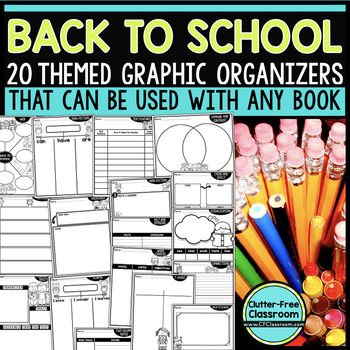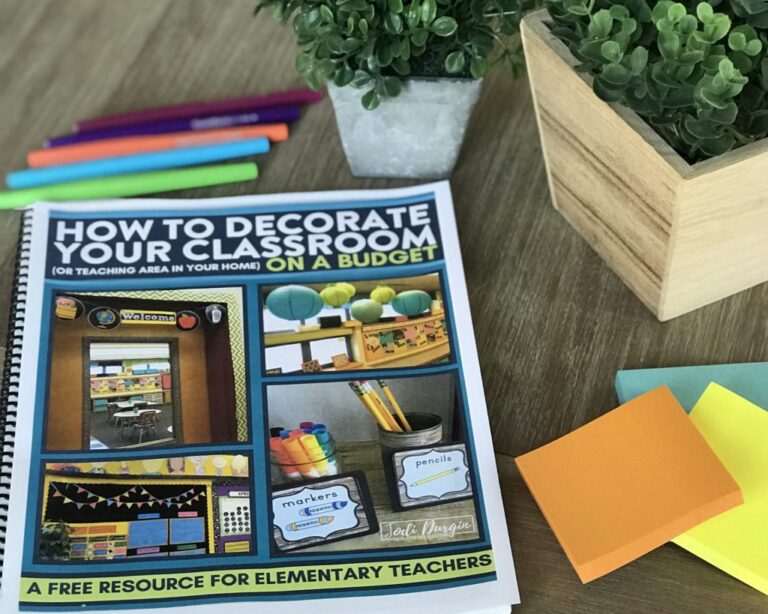At the beginning of the year, your schedule is irregular due to assemblies, picture day, and other special events. It’s important to have extra activities prepped and ready, so you’re never standing in front of your class not sure what to do next. These beginning of the year reading activities are a great option! Learn all about them and how to use them in your classroom below!
What are the Beginning of the Year Reading Activities?
These beginning of the year reading activities are graphic organizers that can be used with any book. They require no prep. Just print and go! There are 5 graphic organizers for fiction texts, 10 for nonfiction texts, and 5 that are multi-purpose. See the breakdown below.
Graphic Organizers for Fiction Texts
- predicting
- sequencing
- story mapping
- summarizing
- character traits
Graphic Organizers for Informational Texts
- schema
- brainstorming / webbing
- identifying facts
- main idea and supporting details
- nonfiction text features
- gathering information
- comparing and contrasting
- cause and effect
- fact and opinion
- note taking
Multi-Purpose Graphic Organizers
- vocabulary and author word choices
- visualizing
- making connection
- sorting information
- report writing / retelling
Why Teachers Love These Beginning of the Year Reading Activities
Some of the reasons teachers love these back to school reading activities include:
- These reading activities require no prep – just print and go!
- They can be used with any book, so all of your students can use the same activity with books at their own level.
- They are reusable, meaning you can use the same organizer over and over with different books. This means you’ll also have the opportunity to reteach and reassess as needed.
- They’re differentiated, which makes it easy to meet the needs of all your learners.
- They can be used for literature centers, readers workshop, writer’s workshop, small group instruction, RtI, morning work, homework and more.
How to Implement These Reading Activities
Below are steps for how to implement these beginning of the year activities in your classroom.
1. Download the Beginning of the Year Reading Activities
Download these back to school reading activities from our Teachers Pay Teachers store.
2. Read the Teacher’s Guide
After you download the resource, read the teacher’s guide to become familiar with the resource and the different types of graphic organizers included in it.
3. Select and Print One of the Graphic Organizer Activities
After reading through the teachers guide and learning about the different types of graphic organizers, select one of the types of graphic organizers from the beginning of the year reading activities packet. Print a copy for each student. It might be helpful to print one or two extra copies just in case you gain a new student or if a student loses theirs.
4. Introduce the First Graphic Organizer Activity to Your Students
Avoid introducing multiple organizers at one time. Instead, allow students to become proficient in using one organizer before working with another. Continue to revisit each organizer over time throughout the school year.
When introducing the organizer, show your students the graphic organizer and invite them to make observations about it. Have them discuss what they see with their peers. Point out the features. During this step, you and the students are simply citing what you see when you look at it.
Next, explain in which situations the specific organizer may be used and how it will help them as a reader.
5. Model How to Complete the Graphic Organizer
Model how to fill in the graphic organizer. Reference the book you are using and narrate the process.
6. Invite Students to Do the Graphic Organizer Activity
Have your students complete their own graphic organizer independently. They should use the same organizer you model, but with a different piece of text. If you feel there is still a need for support, you could work in a small group or plan cooperative learning experiences for peer partner work.
7. Share and Reflect on the Learning Experience as a Class
At the end of the block, give students the opportunity to share their completed work with a peer. Pull students together and reflect on the experience. What did they learn? What did students have trouble with?
8. Reflect on the Learning Experience Independently
Take the time to reflect on your own when looking through students’ work. What do you notice about each student’s work? Is there anything you need to reteach?
9. Reteach if Needed
If the majority of the class had trouble with a specific part of the graphic organizer, then deliver a mini lesson to the whole class based on that component. If just a handful of students struggled with a specific part of the graphic organizer, pull a small group instead.
10. Introduce the Next Graphic Organizer Activity and Repeat
The final step is to select another page from the beginning of the year reading activities and repeat steps 3-9. Simultaneously, students can continue to be working on the previous graphic organizer activity during centers or independent work time.
In closing, we hope you found this information about these beginning of the year reading activities helpful. If you did, then you may also be interested in these posts:



